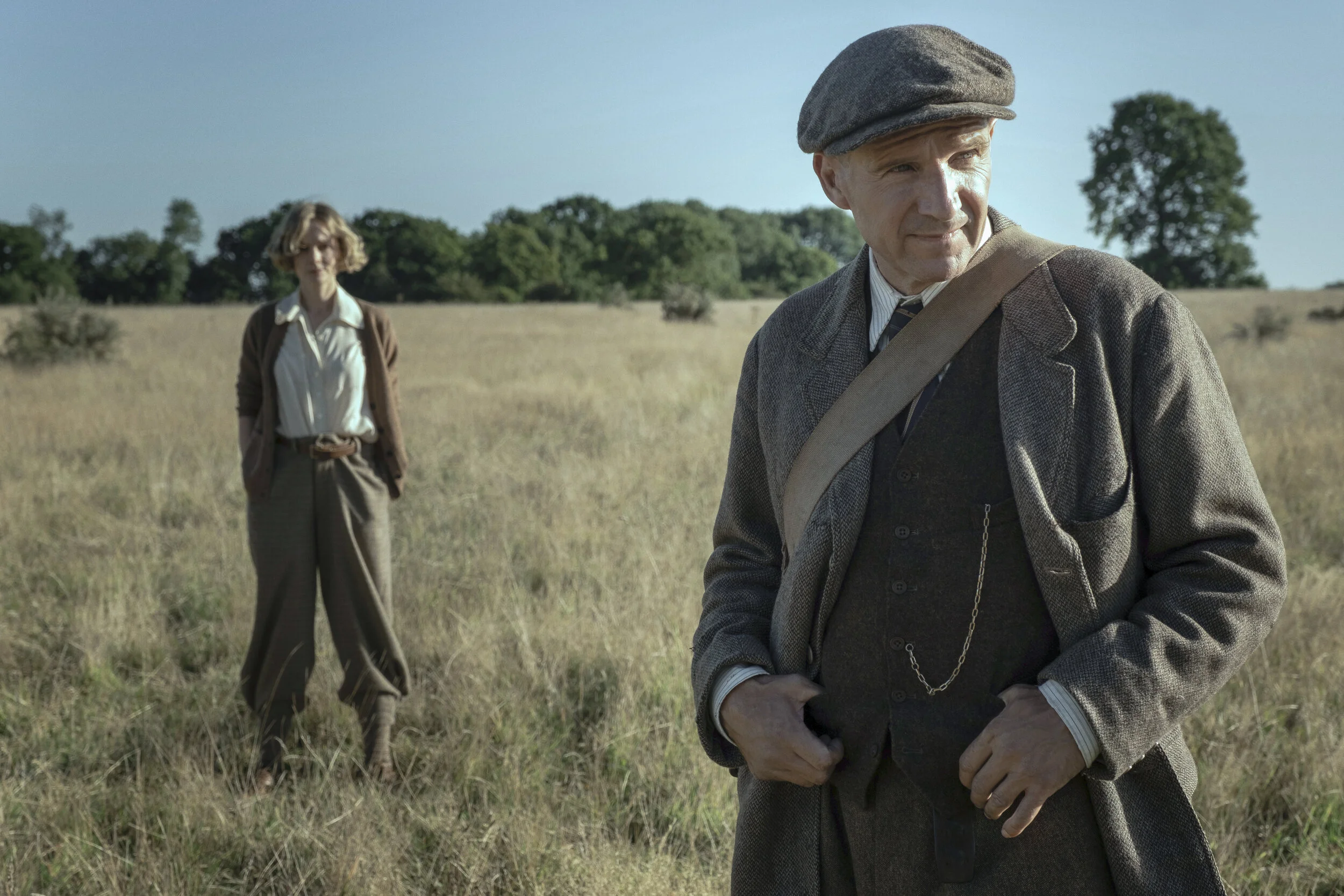The Dig: A pleasingly British period drama about the urge to make history by unearthing it
By Karen Gordon
Rating: B
A stately 20th Century period piece in the style of the best British dramas, The Dig is just what the anglophiles ordered.
Based on the true story of the discovery of Anglo Saxon artifacts at Sutton Hoo in 1939, the film centers on two main characters: Edith Pretty (Carey Mulligan) is a widow who is raising her young son Robert (Archie Barnes) on the estate she bought with her late husband.
Part of their attraction to the property was a series of large ancient man-made mounds that fascinated many for centuries, including King Henry VIII. But no one had ever properly excavated it.
Ralph Fiennes assesses the prospects for a “find” on Carey Mulligan’s property in The Dig.
And now, with war looming and mortality weighing on her, Pretty wants to proceed.
The war effort means the nearby Ipswich Museum doesn’t have the resources to help. They recommend an experienced amateur archeologist they hire regularly for their digs, Basil Brown (Ralph Fiennes).
Brown is a serious, steady, old-fashioned, down-to-earth, unpretentious word-is-my-bond man who knows his stuff. His educated guess is that the mounds are part of an ancient burial ground.
And after surveying the area, he chooses the mound his experience tells him is the best place to start, and, with the help of a local team, starts digging. His instincts pay off with an incredible find - an ancient wooden ship buried in the ground to be used as the tomb of some ancient leader or king.
As word spreads, museum representatives from Ipswich and the British Museum descend on the property aiming to take it over from Brown, whom they see as an inferior. The museums not only vie to take over the dig, but they seek to persuade Pretty to donate all findings to them.
Charles Phillips (Ken Stott) of the British Museum puts his money where his mouth is, bringing support in the form of trained archeologists, newlyweds Penny Piggott (Lily James) and Stuart Piggott (Ben Chaplin) to help with the more detailed work on the excavation site.
PROUDLY SUPPORTS ORIGINAL-CIN
Although The Dig is based on a true story, the film is adapted from a novel by John Preston, who also happens to be Peggy Piggott’s nephew. And so - rather than dealing simply with the story of the excavation, and the excitement and value of what was uncovered - the film splits its focus between the dig and the personal dilemmas of key people involved. Each of the main characters is dealing with some personal stress that comes to the fore in the time they’re together.
Most of the characters, both in his novel and in the film adaptation, are based real people. But to play out some of the movie’s larger themes, screenwriter Moira Buffini created a fictional character, a young man named Rory Lomax (Johnny Flynn), cousin to Edith Pretty, who joins the dig and is a romantic interest for one of the characters
Rory also intends to enlist. The excitement of literally unearthing the past cannot obscure the uncertainty of the coming war.
The Dig is marked by smart, superior acting, restrained emotions, and interesting characters from across classes. Maybe it’s the restraint, maybe it’s the distracting split of focus between the discovery of the treasure, and the characters’ personal lives, but for all of its positives, the film is, at key times, flat and lacks tension. Even the initial discovery of what Brown uncovers is less than it might have been.
The film, although modest in tone, is beautifully cinematic. Shot by Mike Eley, it looks like a movie that should be seen on the big screen where the visuals would add more of a sense of awe to the experience of the film.
To be fair, Director Simon Stone juggles a lot of ideas in The Dig, from bread-and-butter themes like class, repression and honour, to larger, more philosophical ideas about mortality, and making the best of our short lives. There’s an undertone of somehow reassuring continuity in connecting to the distant past and knowing we are creating history by unearthing it.
And he’s kept it all very subtle. Stone has crafted a meticulous film, that feels true to the period in every detail. From the scuffed shoes that upper-class Edith Pretty wears around the house, to the tweedy clothes, he’s shot it so that your eye is drawn to the details of daily life, which adds to the richness and period authenticity of the film.
The acting is uniformly superb, particularly Mulligan and Fiennes (the latter of whom I consider one of cinema’s most undervalued treasures.)
Stone has paid attention to the environment and nature as well. The camera follows Edith Pretty across her property at various times of day, giving the film an almost spiritual quality. Life and death, history and the present moment. Human individuals come and go, but nature persists: there’s a feeling of the eternal here. And a lavish burial chamber may have been a way of honouring a leader. But centuries later, as we look at it all from the present, it’s also someone’s affirmation. They lived. They existed.
The Dig is sometimes slowed by all these ideas. But still, there is much here to enjoy, from the fine acting to the sense of being transported to another time and place. It showcases a moment where people were looking both to the past and into an uncertain future – a moment not unlike the one we’re living through now.
The Dig. Directed by Simon Stone. Written by Moira Buffini from a novel by John Preston. Stars Carey Mulligan, Ralph Fiennes and Lily James. Debuts on Netflix on Friday, January 29, 2021.



